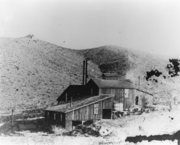
Ivanpah, California
Encyclopedia
Ivanpah was a short-lived silver mining town
located in San Bernardino County
, California
, United States
. It was founded in 1869, and existed until at least the mid-1880s.
), means “clear water.”
By the summer of 1871, Ivanpah had become a small but well-established trading center for a huge district spilling over into Nevada. A traveler came across 15 well-built adobe buildings, including a hotel, 2 stores, the office and headquarters of the Piute Company, and several small houses.
A deep gorge led to the mines, which were scattered about Mineral (Alaska) Hill. The chief properties were the Hite & Chatfield claim, which was soon renamed the Lizzie Bullock, and the Monitor and Beatrice, owned by the McFarlane brothers: Tom, Andrew, John, and William. Six miles southwest of Ivanpah was the Copper World Mine.
Despite litigation and intermittent depressions, the McFarlanes put up a 5-stamp mill near town in 1875, J.A. Bidwell, the new owner of the Lizzie Bullock, built a 10-stamp mill in 1876, and a post office was established in early 1878. By the spring of 1879, the 100 men on Alaska Hill were carrying on a brisk trade at Ivanpah’s 2 saloons, 2 stores, 2 blacksmith shops, 2 shoemakers’ shops, 2 hotels, 2 hay yards, a butcher shop, and several “neat and comfortable” houses. A weekly newspaper, named the Green-Eyed Monster, was founded in early 1880, but it died after a few issues.
The ore, however, was losing its value, and the new camps of Calico and Providence were drawing away miners. The post office was moved to the new smelter camp of Valley Wells in early 1899, and its name was changed to Rosalie. About a dozen stone and adobe ruins remain at the town-site and millsites.
Ghost town
A ghost town is an abandoned town or city. A town often becomes a ghost town because the economic activity that supported it has failed, or due to natural or human-caused disasters such as floods, government actions, uncontrolled lawlessness, war, or nuclear disasters...
located in San Bernardino County
San Bernardino County, California
San Bernardino County is a county in the U.S. state of California. As of the 2010 census, the population was 2,035,210, up from 1,709,434 as of the 2000 census...
, California
California
California is a state located on the West Coast of the United States. It is by far the most populous U.S. state, and the third-largest by land area...
, United States
United States
The United States of America is a federal constitutional republic comprising fifty states and a federal district...
. It was founded in 1869, and existed until at least the mid-1880s.

Location
Ivanpah was located at 35° 32' 42.15" -115° 32' 7.19" (WGS84), on the northeast side of Clark Mountain.History
While searching for copper, the Piute Company of California and Nevada in 1869 found rich deposits of silver ore on the lower slopes of what was soon named Clark Mountain, west of the Nevada line. The company laid out a townsite at Willow Spring, near a wash on the southeast slope, about 9 miles east of the discoveries. The settlement was named Ivanpah, which, roughly translated from an Indian language (probably one of the Numic languagesNumic languages
Numic is a branch of the Uto-Aztecan language family. It includes seven languages spoken by Native American peoples traditionally living in the Great Basin, Colorado River basin, and southern Great Plains. The word Numic comes from the cognate word in all Numic languages for "person." For...
), means “clear water.”
By the summer of 1871, Ivanpah had become a small but well-established trading center for a huge district spilling over into Nevada. A traveler came across 15 well-built adobe buildings, including a hotel, 2 stores, the office and headquarters of the Piute Company, and several small houses.
A deep gorge led to the mines, which were scattered about Mineral (Alaska) Hill. The chief properties were the Hite & Chatfield claim, which was soon renamed the Lizzie Bullock, and the Monitor and Beatrice, owned by the McFarlane brothers: Tom, Andrew, John, and William. Six miles southwest of Ivanpah was the Copper World Mine.
Despite litigation and intermittent depressions, the McFarlanes put up a 5-stamp mill near town in 1875, J.A. Bidwell, the new owner of the Lizzie Bullock, built a 10-stamp mill in 1876, and a post office was established in early 1878. By the spring of 1879, the 100 men on Alaska Hill were carrying on a brisk trade at Ivanpah’s 2 saloons, 2 stores, 2 blacksmith shops, 2 shoemakers’ shops, 2 hotels, 2 hay yards, a butcher shop, and several “neat and comfortable” houses. A weekly newspaper, named the Green-Eyed Monster, was founded in early 1880, but it died after a few issues.
The ore, however, was losing its value, and the new camps of Calico and Providence were drawing away miners. The post office was moved to the new smelter camp of Valley Wells in early 1899, and its name was changed to Rosalie. About a dozen stone and adobe ruins remain at the town-site and millsites.

